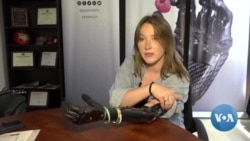ເທັກໂນໂລຈີໃຫມ່ກໍາລັງເອົາຄຸນລັກສະນະບາງຢ່າງທີ່ສະຫລັບສັບຊ້ອນຫຼາຍຂຶ້ນ ຂອງມືມະນຸດໃສ່ມືທຽມ ຫລື ມືໄບໂອນິກ (bionic). Genia Dulot ມີລາຍງານ ກ່ຽວກັບບໍລິສັດນຶ່ງໃນລັດຄາລິຟໍເນຍ ທີ່ກໍາລັງໃຊ້ການສົ່ງຄວາມຮູ້ ສຶກຈາກການສໍາຜັດເພື່ອໃຫ້ຜູ້ໃຊ້ມືທຽມສາມາດຮັບຮູ້ເຖິງວັດຖຸທີ່ເຂົາເຈົ້າກໍາລັງຈັບຢູ່ ຫຼື ກໍາລັງມີການໂຕ້ຕອບກັບ. ບົວສະຫວັນ ມີລາຍລະອຽດເລື້ອງນີ້ມາສະ ເໜີທ່ານໃນອັນດັບຕໍ່ໄປ.
ອະນິກາ ເບີລິນ (Annika Berlin) ໃຊ້ມືທຽມ ຫລື ມື bionic. ນາງຄວບຄຸມມັນ ໂດຍຜ່ານຂົ້ວໄຟຟ້າທີ່ກົດໃສ່ກັບຜິວຫນັງຂອງລໍາແຂນນາງ.
ນາງເບີລິນຜູ້ໃຊ້ມືທຽມ ໄບໂອນິກອະທິບາຍວ່າ:
"ຂ້ອຍກຳລັງເຮັດໃຫ້ປາຍແຂນຂອງຂ້ອຍຫົດເຂົ້າ ຢູ່ຂ້າງນີ້ຂອງແຂນເພື່ອກໍາມືໄວ້ ແລະຫຼັງຈາກນັ້ນຂ້ອຍກໍກົດກ້າມຊີ້ນຢູ່ຂ້າງນອກໜີ້ ໃຫ້ຫົດເຂົ້າ ເພື່ອເປີດມື ອອກ."
ມືໄບໂອນິກ ແມ່ນຜະລິດຕະພັນຂອງບໍລິສັດໄຊໂຢນິກ (Psyonic) ຂອງລັດຄາ ລິຟໍເນຍ. ຜູ້ກໍ່ຕັ້ງບໍລິສັດ, ທ່ານອາດີລ ອັກທາ (Aadeel Akhtar) ກ່າວວ່າ ເທັກໂນໂລຈີ ການຮັບຮູ້ກ້າມຊີ້ນ ແມ່ນມີມາແຕ່ດົນນານແລ້ວ, ແຕ່ມັນມີຄວາມກ້າວຫນ້າໃນເທັກໂນໂລຈີການພິມແບບ 3 ມິຕິ ຫລື 3D ແລະອຸປະກອນຄວບ ຄຸມຂະໜາດນ້ອຍ ຫລື microcontroller ທີ່ອໍານວຍຄວາມສະດວກ ໃນການພັດທະນາຂອງມື. ຫຸ່ນຍົນອ່ອນ ຊ່ວຍເຮັດໃຫ້ມືແຂງແຮງ ແລະເຄື່ອນ ເໜັງໄວ, ແຕ່ທ່ານອັກທາເວົ້າວ່າຄຸນລັກສະນະທີ່ຫນ້າຕື່ນເຕັ້ນທີ່ສຸດກໍຄື ເຄື່ອງຈັບສັນຍານ ຫລື ເຊັນເຊີຄວາມກົດດັນ ຢູ່ໃນນິ້ວມື ເພື່ອສົ່ງຄວາມຮູ້ສຶກ ຈາກການສໍາຜັດໃຫ້ແກ່ຜູ້ໃຊ້ມື.
ທ່ານອັກທາ ຜູ້ກໍ່ຕັ້ງ ແລະ CEO ຂອງບໍລິສັດໄຊໂຢນິກກ່າວວ່າ:
“ເມື່ອເຂົາເຈົ້າຈັບວັດຖຸ, ເຂົາເຈົ້າຈະຮູ້ສຶກເຖິງການສັ່ນສະເທືອນຢູ່ທີ່ຜິວໜັງແລະ ເຂົາເຈົ້າຈະຮູ້ວ່າຕົນໄດ້ສໍາຜັດກັບວັດຖຸ, ເມື່ອເຂົາເຈົ້າປ່ອຍວັດຖຸອອກໄປ, ແລະ ມີຄວາມຮູ້ສຶກຄ້າຍຄືກັນຫນ້ອຍນຶ່ງອີກວ່າ ເຂົາເຈົ້າໃຊ້ຄວາມກົດດັນຫຼາຍປານໃດ ເພື່ອກໍາວັດຖຸນັ້ນໄວ້ໃຫ້ແໜ້ນ.”
ນາງເບີລິນກ່າວວ່າການສົ່ງຄວາມຮູ້ສຶກຈາກການສໍາພັດກໍຫມາຍຄວາມວ່າ ເມື່ອນາງຈັບຈອກກາເຟຂຶ້ນມາ ໂດຍທີ່ນາງບໍ່ຈໍາເປັນຕ້ອງໄດ້ຫຼຽວໄປເບິ່ງໃຫ້ຮູ້ຄັກ ແນ່ວ່າມືຂອງນາງຈັບຫຍັງ.
ທ່ານອັກທາ ກ່າວວ່າ ຂັ້ນຕອນຕໍ່ໄປແມ່ນການເອົາມືຕິດໃສ່ໂດຍກົງໃນກະດູກ ຂອງຜູ້ໃຊ້ດ້ວຍເທັກໂນໂລຈີຝັງເສັ້ນປະສາດ ທີ່ຈະຊ່ວຍໃຫ້ນິ້ວມືແຕ່ນິ້ວ ສາ ມາດ ທໍາການຄວບຄຸມໄດ້.
ທ່ານກ່າວດັ່ງນີ້:
"ໂດຍທີ່ມີສິ່ງນັ້ນ, ພວກເຮົາຫວັງວ່າພາຍໃນສອງສາມປີພວກເຮົາອາດຈະເຮັດ ໃຫ້ຄົນເຈັບກຸ່ມທໍາອິດຂອງພວກເຮົາ ສາມາດຫຼິ້ນເປຍໂນ ຫຼືພິມເທິງແປ້ນພິມ ຄອມພິວເຕີໄດ້ຄືນອີກ."
ທ່ານກ່າວຕໍ່ໄປວ່າ:
"ຖ້າທ່ານສ້າງຫຸ່ນຍົນ ເພື່ອໃຫ້ເຮັດໄດ້ແບບດຽວກັນກັບມະນຸດ, ແລ້ວຈາກນັ້ນ ທ່ານກໍສາມາດນໍາໃຊ້ມືຂອງພວກເຮົາສໍາລັບຫຸ່ນຍົນໄດ້ເຊັ່ນກັນ."
ມືຂອງບໍລິສັດໄຊໂຢນິກ ແມ່ນສ່ວນນຶ່ງຂອງຫຸ່ນຍົນທີ່ມີຮູບຮ່າງແບບມະນຸດ ນັກບິນອາວະກາດ ຊື່ວ່າວອລກີຣິ (Valkyrie) ຂອງອົງການນາຊາ (NASA) ເຊິ່ງອົງການດັ່ງກ່າວ ກຳລັງກະກຽມທີ່ຈະເອົາມັນໄປໃຊ້ຢູ່ໃນອາວະກາດ.
ອ່ານລາຍງານນີ້ເປັນພາສາອັງກິດຂ້າງລຸ່ມ:
New technologies are giving bionic hands some of the more complex features of human hands. Genia Dulot reports on a California company that is using touch feedback to give users a sense of the objects they are holding or interacting with.
Annika Berlin uses a bionic hand. She controls it through electrodes pressed against the skin of her forearm.
Annika Berlin, Bionic Hand User:
“I’m contracting the end of my arm on this side of my arm to close it, and then I’m contracting the muscle out here to open the hand.”
The bionic hand is a product of the California firm Psyonic. Founder Aadeel Akhtar says the muscle-sensing technology has been around for a while, but it is advances in 3D printing and microcontroller technology that has facilitated the hand’s development. Soft robotics helped make the hand robust and fast, but Akhtar says the most exciting feature is pressure sensors in the fingers to give users touch feedback.
Aadeel Akhtar, Psyonic Founder and CEO:
“When they grab an object, they will feel a vibration on their skin, and they’ll know that they’ve touched the object, when they let go of the object, and also have a little bit of semblance of how much pressure they are applying on the object as well.”
Berlin says that touch feedback means that when she picks up a cup of coffee, she no longer has to visually check her grip.
Akhtar says the next step is integrating the hand directly into the bones of the user with nerve implant technology that would allow individual finger control.
Aadeel Akhtar, Psyonic Founder and CEO:
“With that we’re hoping that within a couple years we might get our first patients to play piano or type on a keyboard again.”
Nats, robotic hand:
"If you are building a robot, to do the same things that humans are, then you can use our hand for robots as well."
The Psyonic hand is part of NASA’s humanoid astronaut robot Valkyrie, which the agency is preparing to use in space.





